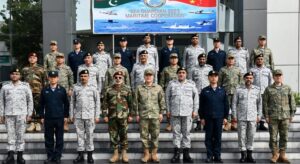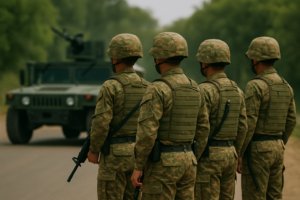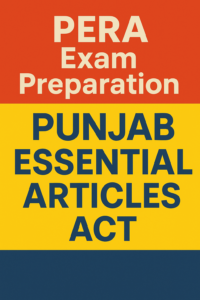The U.S.-China trade war, initially ignited in 2018 by then-President Donald Trump and reignited with full force in 2025, is reshaping global trade flows and economic alliances.
While much attention focuses on the direct impacts on these two economic giants, the broader repercussions for countries like Pakistan are equally critical.
As a growing economy heavily reliant on exports—particularly textiles—Pakistan faces both formidable challenges and unique opportunities in this shifting global landscape. In order to withstand external shocks and sustain growth, Pakistan must urgently recalibrate its trade strategies, diversify its markets, and strengthen regional economic ties.
In recent years, trade between Pakistan and the United States has grown considerably, reaching approximately $5.4 billion in 2024, with textiles and apparel accounting for over 70% of Pakistan’s exports to the U.S.
Although Pakistan has so far avoided heavy punitive tariffs aimed directly at its products, the general increase in tariff rates and the tightening of U.S. customs policies have indirectly impacted Pakistani exporters.
As a result, increased scrutiny, longer processing times, and higher compliance costs have emerged as significant barriers to trade. It is important to note that tariff rates for many developing countries, including Pakistan, remain between 5–10% on key exports, which is far more favorable compared to the up to 145% tariffs imposed on Chinese goods.
Nevertheless, the environment remains precarious, as categories such as textiles, leather goods, and light machinery are increasingly subjected to non-tariff barriers and administrative bottlenecks.
Meanwhile, the sectors most heavily targeted by the U.S. tariffs include heavy machinery, electronics and semiconductors, textiles and apparel, agricultural products such as soybeans and pork, and automotive parts.
While Pakistan has not been a direct target in most of these areas, the indirect impacts are undeniable. Global input costs have risen, and demand volatility in the U.S. market has created additional risks, particularly in textiles and machinery where Pakistan has significant exposure.
Turning to the impact on Pakistan’s broader economy, it is evident that export vulnerabilities remain a pressing concern. Pakistan’s dependence on a narrow export base—chiefly textiles—and its heavy reliance on the U.S. market expose its economy to significant external shocks.
Future escalation in U.S. protectionist measures could further erode Pakistan’s competitiveness. Moreover, delays, logistics cost hikes, and rising raw material prices are already squeezing profit margins for Pakistani exporters.
Beyond the export sector, macroeconomic challenges have also intensified. The trade war has exacerbated global inflation and disrupted supply chains, triggering higher import costs, especially for industrial machinery and chemical inputs.
Simultaneously, the heightened demand for dollars has placed increased pressure on the Pakistani Rupee, leading to currency instability. Furthermore, reduced foreign investment, as global investors gravitate toward more stable markets, threatens Pakistan’s fragile economic recovery and deepens its balance-of-payments challenges.
Nevertheless, despite these headwinds, the evolving global order offers Pakistan an opportunity to recalibrate its economic trajectory.
Strengthening regional economic forums stands out as a critical strategy. By accelerating industrial and export zone development through the China-Pakistan Economic Corridor (CPEC), Pakistan can enhance its industrial capacity and boost exports. Additionally, efforts to revitalize the South Asian Association for Regional Cooperation (SAARC) initiatives could open new avenues for tapping into neighboring markets.
Similarly, leveraging Belt and Road Initiative (BRI) linkages presents a promising path to access Central Asian and Middle Eastern markets.
At the same time, diversifying export markets is equally crucial. Pakistan must actively target emerging economies in Africa, Central Asia, and Eastern Europe to reduce its reliance on traditional partners.
Negotiating new Preferential Trade Agreements (PTAs) with ASEAN and African Union countries would further strengthen Pakistan’s position in global trade.
Expanding the product base is another vital priority. Investing in high-value textile sectors, such as technical textiles and fashion apparel, can help Pakistan climb the value chain.
Additionally, promoting sectors like IT services, agri-tech, pharmaceuticals, and sports goods would diversify export earnings and reduce vulnerability. Developing local machinery production would also decrease dependency on costly imports and enhance self-reliance.
In parallel, reviving the Generalized System of Preferences (GSP) status must be pursued vigorously. Launching diplomatic efforts to regain or enhance GSP privileges in both U.S. and European markets would secure much-needed tariff relief and bolster export competitiveness.
In conclusion, the U.S.-China trade war has exposed vulnerabilities across global trade systems and amplified risks for export-dependent economies like Pakistan. However, it also serves as a pivotal call to action.
Pakistan must modernize its economy, diversify its markets, and foster deeper regional integration. Through strategic foresight, bold reforms, and proactive diplomacy, Pakistan can not only mitigate the negative ripple effects but also emerge stronger, more resilient, and more globally connected in the evolving economic order.
📍 English Language Educator | Blogger & Content Strategist | 7+ Years in Educational Blogging
Nosheen Bashir is a dedicated English teacher and experienced blogger with over seven years of expertise in content creation and educational writing. Passionate about language, literature, and effective communication, she combines her teaching experience with blogging skills to create insightful, research-backed content that helps learners and educators alike.
🔹 Expertise & Achievements:
✔ English Language Education: A skilled educator with years of experience in teaching English grammar, literature, and communication skills to students of varying levels.
✔ Educational Blogging: Running a successful blog for 7+ years, delivering well-structured, engaging content on language learning, writing techniques, and academic success.
✔ SEO & Content Strategy: Specializes in creating high-ranking, authoritative articles that follow Google’s EEAT principles, ensuring content that is both informative and search-friendly.
✔ Student-Centric Approach: Committed to making English easier, engaging, and accessible, helping readers and students improve their language proficiency.
🚀 With a passion for teaching and writing, Nosheen Bashir is dedicated to crafting educational content that empowers students, teachers, and language enthusiasts worldwide.









